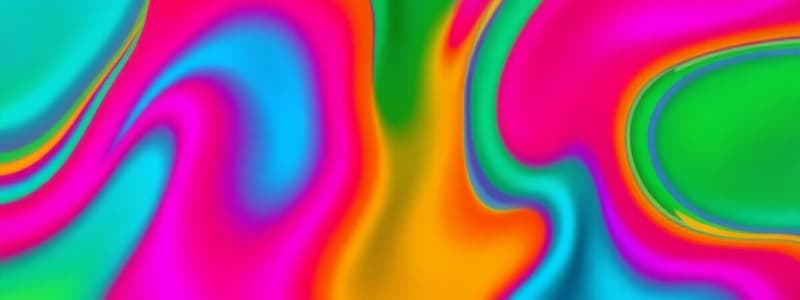Podcast
Questions and Answers
Which of the following best describes the primary function of a framebuffer in OpenGL?
Which of the following best describes the primary function of a framebuffer in OpenGL?
- To manage the pipeline stage of tessellation shaders.
- To store depth information for shadow mapping.
- To directly render to a texture instead of the default screen buffer. (correct)
- To perform geometry processing before lighting calculations.
In a deferred rendering pipeline, what is the correct order of the principal steps?
In a deferred rendering pipeline, what is the correct order of the principal steps?
- Geometry pass, Lighting calculation, Post-processing. (correct)
- Lighting calculation, Geometry pass, Post-processing.
- Post-processing, Geometry pass, Lighting calculation.
- Geometry and Lighting combined pass, Post-processing.
What is the main capability that geometry shaders bring to the graphics pipeline?
What is the main capability that geometry shaders bring to the graphics pipeline?
- Applying materials and textures to rendered objects.
- Subdividing geometry based on a heightmap.
- Generating new geometry, such as points, lines, or triangles, from primitives. (correct)
- Performing complex geometric calculations like intersections.
Which of these statements accurately describes the function of Tessellation Shaders?
Which of these statements accurately describes the function of Tessellation Shaders?
Which shader type is best suited for performing general-purpose computations unrelated to the traditional graphics rendering pipeline?
Which shader type is best suited for performing general-purpose computations unrelated to the traditional graphics rendering pipeline?
Flashcards
What is a framebuffer?
What is a framebuffer?
An OpenGL object that allows rendering directly to a texture instead of the primary screen buffer.
What is Shadow Mapping?
What is Shadow Mapping?
A technique that renders the scene from the light's perspective to store depth information for simulating shadows.
What is Deferred Rendering?
What is Deferred Rendering?
A rendering technique that separates geometry processing from lighting calculations for improved efficiency in scenes with many lights.
What is a Geometry Shader?
What is a Geometry Shader?
Signup and view all the flashcards
What is a Tessellation Shader?
What is a Tessellation Shader?
Signup and view all the flashcards
Signup and view all the flashcards
Study Notes
Framebuffers
- A framebuffer is an OpenGL object for rendering directly to a texture instead of the screen.
- It can have color, depth, and stencil attachments.
- Color attachments store the rendered image.
- Depth and stencil attachments are for depth testing and stencil operations.
- Renderbuffers are used for depth/stencil attachments when sampling isn't needed.
- Steps for using a framebuffer:
- Generate a framebuffer using
glGenFramebuffers. - Bind the framebuffer using
glBindFramebuffer. - Attach textures or renderbuffers using
glFramebufferTexture2DorglFramebufferRenderbuffer. - Check completeness with
glCheckFramebufferStatus. - Bind back to the default framebuffer for screen rendering.
- Generate a framebuffer using
- Applications include post-processing effects (e.g., bloom, motion blur) and shadow mapping, deferred rendering.
Shadow Mapping
- A technique to simulate shadows by rendering the scene from the light's perspective and storing depth information.
- Steps:
- Render the scene from the light's perspective to create a depth map.
- Render the scene from the camera's perspective, comparing fragment depths to the depth map.
- Key term: Depth Map: A texture storing the distances from the light to objects in the scene.
- Tips for shadow mapping:
- Shadow acne (artifacts from depth comparison precision issues)
- PCF (Percentage Closer Filtering) for smoother shadow edges
Deferred Rendering
- Separates geometry processing from lighting calculations for better efficiency in scenes with many lights.
- Pipeline:
- G-Buffer Generation: Render scene geometry (positions, normals, albedo) into multiple textures.
- Lighting Pass: Use data from the G-Buffer to calculate lighting.
- Final Pass: Combine lighting results with other effects.
- Advantages: Efficient for scenes with many lights, decouples geometry and lighting passes.
- Disadvantages: High memory usage due to G-Buffers, difficult to integrate transparency.
Geometry Shaders
- Shader stage to generate new geometry (points, lines, or triangles) from input primitives.
- Key features: add/modify geometry on-the-fly, useful for tasks like generating billboards, extruding geometry for outlines, and creating particle systems.
Tessellation Shaders
- Shaders that subdivide geometry for finer detail, controlled by a height map or procedural logic.
- Pipeline:
- Tessellation Control Shader (TCS): Determines how much to subdivide input geometry.
- Tessellation Evaluation Shader (TES): Calculates new vertex positions after subdivision.
- Applications include smooth curves/surfaces, dynamic level of detail (LOD), and terrain rendering.
- Tips: use tessellation sparingly to balance performance and visual fidelity, combine with displacement maps for realistic details.
Compute Shaders
- Programmable shader stage for general-purpose computations without being tied to the rendering pipeline.
- Key features: operates on data in parallel using threads, useful for tasks like physics simulations, particle systems, and image processing (e.g., Gaussian blur).
Physically Based Rendering (PBR) + Image-Based Lighting (IBL)
- PBR is a rendering approach that mimics real-world light interactions.
- Relies on:
- Albedo (base color), Roughness (reflection sharpness), Metalness (metallic/dielectric surface), and Normal Maps (surface detail).
- Key equations: Bidirectional Reflectance Distribution Function (BRDF) combines diffuse and specular lighting. Specular uses Cook-Torrance model, diffuse uses Lambertian model.
- IBL uses high-dynamic-range (HDR) environment maps for realistic lighting.
- Includes reflection maps for glossy surfaces and irradiance maps for diffuse lighting.
- Tips: precompute environment maps for efficiency, ensure HDR textures for high quality lighting.
General Advice for Assessment
- Be prepared to explain why each technique is used, its limitations, and relate it to practical use cases. Use diagrams to illustrate concepts where possible.
Studying That Suits You
Use AI to generate personalized quizzes and flashcards to suit your learning preferences.




